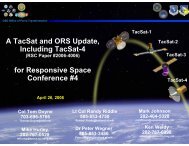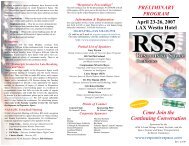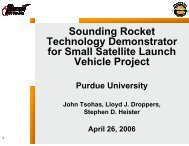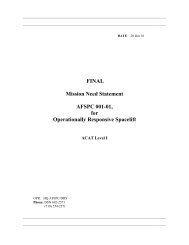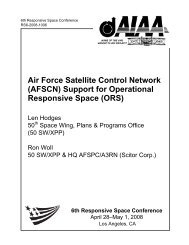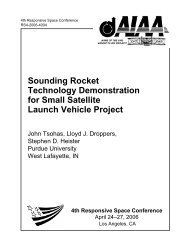TopSat-Assessing the Military Utility of a Tactical ISTAR Demonstrator
TopSat-Assessing the Military Utility of a Tactical ISTAR Demonstrator
TopSat-Assessing the Military Utility of a Tactical ISTAR Demonstrator
You also want an ePaper? Increase the reach of your titles
YUMPU automatically turns print PDFs into web optimized ePapers that Google loves.
6th Responsive Space Conference<br />
RS6-2008-6003<br />
<strong>TopSat</strong>-<strong>Assessing</strong> <strong>the</strong> <strong>Military</strong><br />
<strong>Utility</strong> <strong>of</strong> a <strong>Tactical</strong> <strong>ISTAR</strong><br />
<strong>Demonstrator</strong><br />
H.S. Jolly<br />
Defence Science Technology Laboratory, UK<br />
T. Burt<br />
Royal Air Force, UK<br />
D.W. Beard<br />
Defence Science Technology Laboratory, UK<br />
6th Responsive Space Conference<br />
April 28–May 1, 2008<br />
Los Angeles, CA
AIAA-RS6-2008-6003<br />
<strong>TopSat</strong>- <strong>Assessing</strong> <strong>the</strong> <strong>Military</strong> <strong>Utility</strong> <strong>of</strong> a <strong>Tactical</strong> <strong>ISTAR</strong><br />
<strong>Demonstrator</strong><br />
H. S. Jolly<br />
Defence Science and Technology Laboratory<br />
Dstl Information Management Department, Portsdown Hill, Fareham, PO14 6AD, UK<br />
HSJolly@dstl.gov.uk<br />
T. Burt<br />
Royal Air Force, MoD Main Building, London, SW1A 2HB, UK<br />
D.W. Beard<br />
Defence Science and Technology Laboratory<br />
Dstl Joint Systems Department, Portsdown Hill, Fareham, PO14 6AD, UK<br />
DWBeard@dstl.gov.uk<br />
ABSTRACT<br />
Launched on 25 October 2005, <strong>TopSat</strong> is a small (
AIAA-RS6-2008-6003<br />
INTRODUCTION<br />
<strong>TopSat</strong> is a small, (~108kg) low-cost (
AIAA-RS6-2008-6003<br />
Off nadir<br />
viewing<br />
capability<br />
axis aspheric design<br />
Body pointing capability<br />
<strong>of</strong> ± 30º in two axes<br />
The TUG was chaired by MoD EC(<strong>ISTAR</strong>) and its<br />
roles were to define <strong>the</strong> user community requirements<br />
and to prioritise <strong>TopSat</strong> tasking. The TUG met bimonthly<br />
and was <strong>the</strong> primary vehicle for <strong>the</strong><br />
coordination <strong>of</strong> <strong>the</strong> assessment <strong>of</strong> <strong>the</strong> system’s utility.<br />
THE GENERAL ASSESSMENT OF MILITARY<br />
UTILITY<br />
Downlink<br />
X-band and<br />
S-band<br />
Ground<br />
stations<br />
10M bits/second<br />
Fixed ground station at<br />
West Freugh in Scotland<br />
with a 13m dia. dish and<br />
links at S and X-band.<br />
Transportable ground<br />
station (RAPIDS) with a<br />
3m dia. dish and X-band<br />
link<br />
Lifetime 1 year Exceeded<br />
To ground stations in<br />
line <strong>of</strong> sight<br />
<strong>TopSat</strong> can be employed in two distinct roles:<br />
a. In a standard role with tasking and data down-linked<br />
via <strong>the</strong> QinetiQ ground-station at West Freugh.<br />
b. In a tactical or in-<strong>the</strong>atre operational role with<br />
tasking by deployed units, and <strong>the</strong> use <strong>of</strong> <strong>the</strong> mobile<br />
ground-station RAPIDS for local data down-linking.<br />
For MoD operations, data was always down-linked to<br />
West Freugh, even when RAPIDS was used in <strong>the</strong>atre.<br />
MoD USERS AND THE USE OF IMAGERY<br />
Prior to <strong>the</strong> launch <strong>of</strong> <strong>the</strong> satellite, <strong>the</strong> <strong>TopSat</strong><br />
Consortium contacted representative from a range <strong>of</strong><br />
potential user organisations within MoD. These were<br />
ei<strong>the</strong>r existing exploiters <strong>of</strong> imagery or headquarters<br />
units. In many cases <strong>the</strong>y were unfamiliar with<br />
intelligence, surveillance, targeting and reconnaissance<br />
(<strong>ISTAR</strong>) satellites that could be tasked directly. This<br />
group, <strong>the</strong> <strong>TopSat</strong> Users Group (TUG), was expanded<br />
to include representatives from <strong>the</strong> US Air Force<br />
Research Laboratory (AFRL) and Defence Research<br />
and Development Canada (DRDC) who were<br />
collaborating with Dstl under <strong>the</strong> Trinational<br />
Technology Research and Development Programme.<br />
<strong>Military</strong> utility assessments can be carried out in two<br />
complementary, ways:<br />
a. By using operational analysis (OA) methods<br />
such as modelling to evaluate <strong>the</strong> contribution <strong>of</strong> <strong>the</strong><br />
systems in representative scenarios. This approach<br />
cannot include all <strong>the</strong> real world features and is only as<br />
good as <strong>the</strong> assumptions that are used (including <strong>the</strong><br />
user requirements) but does provide a broad answer<br />
over a range <strong>of</strong> conditions.<br />
b. Operational experimentation trials. This<br />
approach can provide practical experience and valuable<br />
insights into <strong>the</strong> operation <strong>of</strong> systems. It can also<br />
provide opportunities to explore concepts <strong>of</strong> use and for<br />
interactions between users and system specialists.<br />
However, it is necessarily limited in terms <strong>of</strong> <strong>the</strong> range<br />
<strong>of</strong> applications and conditions that can be explored.<br />
The work presented within this paper concentrated on<br />
<strong>the</strong> second approach only.<br />
ASSESSMENT<br />
Because <strong>of</strong> <strong>the</strong> importance <strong>of</strong> <strong>the</strong> Intelligence Cycle;<br />
Direct, Collect, Process and Dissemination (DCPD), <strong>the</strong><br />
military utility assessment <strong>of</strong> <strong>TopSat</strong> was evaluated<br />
against each element separately.<br />
The assessment was carried out for <strong>the</strong> complete<br />
<strong>TopSat</strong> system comprising; <strong>the</strong> satellite, ground stations<br />
and operations infrastructure.<br />
Direct<br />
The Direct activity includes <strong>the</strong> tasking <strong>of</strong> <strong>the</strong> satellite,<br />
scheduling <strong>of</strong> collection and prioritising <strong>the</strong> tasks. It<br />
concludes on <strong>the</strong> receipt <strong>of</strong> <strong>the</strong> confirmation <strong>of</strong><br />
acceptance by <strong>the</strong> satellite operator to <strong>the</strong> User.<br />
User tasking <strong>of</strong> <strong>TopSat</strong> was, via a direct interface<br />
(telephone or/and e-mail) to <strong>the</strong> <strong>TopSat</strong> Payload<br />
Operations Centre, operated by QinetiQ, in<br />
Farnborough UK.<br />
Imagery requestors were defined as ei<strong>the</strong>r ‘remote’ or<br />
‘local’:<br />
a. A remote requestor having a requirement for <strong>TopSat</strong><br />
imagery would place a request direct with <strong>the</strong> <strong>TopSat</strong><br />
Consortium’s point <strong>of</strong> contact, with <strong>the</strong> necessary<br />
image acquisition procedures, and also provide<br />
© British Crown copyright-Dstl 2008 – published with <strong>the</strong> permission <strong>of</strong> <strong>the</strong> Controller <strong>of</strong> Her Majesty’s Stationary Office<br />
3<br />
AIAA/6th Responsive Space Conference 2008
AIAA-RS6-2008-6003<br />
instructions for <strong>the</strong> dissemination <strong>of</strong> <strong>the</strong> acquired data<br />
to <strong>the</strong> requestor.<br />
b. A local requestor was one deployed in situ with <strong>the</strong><br />
RAPIDS mobile ground station. Here <strong>the</strong> requestor<br />
would place <strong>the</strong>ir image request directly with <strong>the</strong><br />
<strong>TopSat</strong> Consortium staff deployed with RAPIDS. The<br />
request was <strong>the</strong>n relayed and agreed with <strong>the</strong> <strong>TopSat</strong><br />
Payload Operations Centre in Farnborough using voice<br />
or data communication routes.<br />
The <strong>TopSat</strong> Industrial Consortium did not set tasking<br />
priorities, requiring instead, MoD to set <strong>the</strong>m. Because<br />
<strong>the</strong> image capacity <strong>of</strong> <strong>the</strong> system was low, conflicts in<br />
tasking priorities did not arise. However, for any future<br />
operational system, users agreed that some mechanism<br />
to set task priorities would be required if conflicts in<br />
tasking requests are to be avoided.<br />
In an attempt to manage request co-ordination between<br />
<strong>the</strong> multiple <strong>TopSat</strong> users, <strong>the</strong> internet based <strong>TopSat</strong><br />
Image Request Analysis Tool (TIRAT) was produced<br />
by <strong>the</strong> <strong>TopSat</strong> Consortium to display <strong>the</strong> location <strong>of</strong><br />
<strong>TopSat</strong> image requests and collected images. This was<br />
intended to allow users to identify where <strong>the</strong>ir requests<br />
overlapped with those <strong>of</strong> o<strong>the</strong>r image requestors or to<br />
identify images already taken which satisfied <strong>the</strong> image<br />
requirement. The initiative illustrated <strong>the</strong> requirement<br />
for an easy to use imagery request tool, both for users<br />
and for <strong>the</strong> managers <strong>of</strong> such systems.<br />
<strong>TopSat</strong> tasking also demonstrated <strong>the</strong> need to<br />
incorporate meteorological data into <strong>the</strong> scheduling and<br />
tasking process as cloud cover over targets reduced <strong>the</strong><br />
number <strong>of</strong> usable images to approximately 60% <strong>of</strong> <strong>the</strong><br />
total taken during all MoD trials.<br />
The time taken to Direct <strong>the</strong> sensor was driven by <strong>the</strong><br />
time taken for <strong>the</strong> satellite to be in line <strong>of</strong> sight <strong>of</strong> <strong>the</strong><br />
tracking, telemetry and command (TT&C) ground<br />
station for upload <strong>of</strong> <strong>the</strong> tasking. The maximum time<br />
for this process was twelve hours. This period could,<br />
for a future operational system, be reduced by <strong>the</strong> use<br />
<strong>of</strong> multiple ground stations or/and through <strong>the</strong> use <strong>of</strong><br />
command relay satellites to <strong>the</strong> time taken to request<br />
that image, schedule <strong>the</strong> sensor in order <strong>of</strong> <strong>the</strong> priority<br />
<strong>of</strong> <strong>the</strong> request and respond to <strong>the</strong> requester with an<br />
expected time <strong>of</strong> delivery <strong>of</strong> <strong>the</strong> image; a total period <strong>of</strong><br />
<strong>the</strong> order <strong>of</strong> a few hours, depending on <strong>the</strong> scheduling<br />
and request co-ordination tasks (and <strong>the</strong> number <strong>of</strong><br />
satellites in <strong>the</strong> constellation).<br />
No specific experiments were conducted to probe <strong>the</strong><br />
Direct aspect <strong>of</strong> <strong>the</strong> <strong>TopSat</strong> System’s utility.<br />
Consequently, <strong>the</strong> assessments were based on<br />
examination and feedback from <strong>the</strong> users post trials.<br />
Collect<br />
Collection for a satellite system can be considered as<br />
<strong>the</strong> process <strong>of</strong> <strong>the</strong> transit to <strong>the</strong> target location after<br />
receipt <strong>of</strong> <strong>the</strong> command, collecting <strong>the</strong> image <strong>of</strong> <strong>the</strong><br />
target location and <strong>the</strong>n downloading <strong>the</strong> image data to<br />
a ground station.<br />
The time taken for a single space-based sensor to access<br />
a geographic location <strong>of</strong> interest is largely set by <strong>the</strong><br />
orbital motion and <strong>the</strong> field <strong>of</strong> regard <strong>of</strong> <strong>the</strong> satellite.<br />
Consequently <strong>the</strong> duration <strong>of</strong> <strong>the</strong> collection process can<br />
be, for single satellite system such as <strong>TopSat</strong>, up to<br />
about three days depending on <strong>the</strong> location <strong>of</strong> <strong>the</strong> target.<br />
This interval could be reduced to at least once a day if a<br />
constellation <strong>of</strong> 3 or more satellites or tuned orbits were<br />
used. As a result, this aspect <strong>of</strong> <strong>the</strong> utility <strong>of</strong> <strong>the</strong> <strong>TopSat</strong><br />
system must be viewed in <strong>the</strong> context <strong>of</strong> assessing a<br />
demonstrator system as opposed to an operational<br />
constellation consisting <strong>of</strong> several satellites.<br />
Reliance on <strong>the</strong> TDI function to mitigate <strong>the</strong> low signal<br />
to noise ratio <strong>of</strong> <strong>the</strong> small aperture imager means that<br />
<strong>the</strong> <strong>TopSat</strong> imager is able to capture no more than 1-2<br />
images per pass. Fur<strong>the</strong>rmore, <strong>the</strong> TDI driven<br />
requirements for satellite agility also means that <strong>the</strong><br />
satellite is also power limited due to <strong>the</strong> use <strong>of</strong> body<br />
mounted solar panels (as opposed to larger, deployable<br />
ones). Consequently <strong>the</strong> capabilities <strong>of</strong> <strong>TopSat</strong> have<br />
been limited by its small size.<br />
Although close to <strong>the</strong> demonstrator satellite’s<br />
specification, <strong>the</strong> probability <strong>of</strong> imaging a target within<br />
an image <strong>of</strong> ~70% was considered too low for an<br />
operational system due to <strong>the</strong> use <strong>of</strong> earth-horizon<br />
sensors over star trackers.<br />
Process<br />
The Process task can be defined as <strong>the</strong> activities<br />
required to turn <strong>the</strong> raw data received by <strong>the</strong> satellite<br />
ground-station to usable intelligence, in whatever form.<br />
The time taken to process <strong>the</strong> data into JPEG or TiFF<br />
files was measured in hours. To process <strong>the</strong>se into georeferenced/rectified<br />
image products (GeoTIFF) image<br />
reference points archived from o<strong>the</strong>r systems, such as<br />
LandSat were used. Consequently, from a strategic<br />
aspect, <strong>the</strong> data was <strong>of</strong> use but from a tactical or<br />
operational use, <strong>the</strong> data would have had limited value,<br />
particularly for maritime surveillance where no land<br />
features were imaged. This and <strong>the</strong> uncertainty <strong>of</strong> <strong>the</strong><br />
© British Crown copyright-Dstl 2008 – published with <strong>the</strong> permission <strong>of</strong> <strong>the</strong> Controller <strong>of</strong> Her Majesty’s Stationary Office<br />
4<br />
AIAA/6th Responsive Space Conference 2008
AIAA-RS6-2008-6003<br />
geographical location <strong>of</strong> <strong>the</strong> centre point <strong>of</strong> any image<br />
due to <strong>the</strong> pointing errors <strong>of</strong> <strong>the</strong> <strong>TopSat</strong> system were<br />
considered to limit <strong>the</strong> utility <strong>of</strong> <strong>the</strong> <strong>TopSat</strong> products.<br />
Some tactical/operational users indicated that JPEG<br />
files <strong>of</strong> <strong>TopSat</strong> imagery provided as much information<br />
as TiFF files near a tenth <strong>of</strong> <strong>the</strong> file size. As tactical<br />
users require image data in small files that can be sent<br />
and received quickly over limited bandwidth links (i.e.<br />
to facilitate timely dissemination); <strong>the</strong>y do not,<br />
typically, require large detailed images, particularly if<br />
<strong>the</strong> equipment to support <strong>the</strong> products is unavailable or<br />
<strong>of</strong> limited supply in <strong>the</strong>atre. As a consequence <strong>of</strong> <strong>the</strong>se<br />
issues, GeoTIFF or, preferably, geo-rectified JPEG<br />
processed to allow mensuration were considered to be<br />
<strong>the</strong> optimum file format for <strong>the</strong> tactical user with higher<br />
levels <strong>of</strong> processing being carried out for strategic<br />
purposes in slower time.<br />
Disseminate<br />
Dissemination is <strong>the</strong> distribution <strong>of</strong> information or<br />
intelligence to <strong>the</strong> appropriate decision maker.<br />
Typically, <strong>the</strong> dissemination function consisted <strong>of</strong> <strong>the</strong><br />
production <strong>of</strong> a CD-ROM by <strong>the</strong> <strong>TopSat</strong> consortium for<br />
dispatch by Royal Mail or courier to <strong>the</strong> User. This<br />
dissemination process was used as <strong>the</strong> TiFF data files<br />
were too large to send be e-mail.<br />
The aspect <strong>of</strong> <strong>the</strong> dissemination process that impacted<br />
on <strong>the</strong> utility <strong>of</strong> <strong>the</strong> system <strong>the</strong> most was transferring<br />
<strong>the</strong> large data files to <strong>the</strong> tactical users. Consequently,<br />
experiments were undertaken to explore <strong>the</strong> key issue<br />
<strong>of</strong> data dissemination. These included:<br />
• The use <strong>of</strong> commercial (Inmarsat Ltd) satellite<br />
broadband global area network services (BGAN) to<br />
transfer JPEG <strong>TopSat</strong> images directly to a User in<br />
<strong>the</strong>atre;<br />
• The use <strong>of</strong> RAPIDS located near to <strong>the</strong> telemetry,<br />
tracking and telecommand ground station to<br />
demonstrate <strong>the</strong> tasking, image collection and<br />
download in a single satellite pass.<br />
The latter test demonstrated that very high timeliness<br />
and freshness <strong>of</strong> imagery is feasible; a responsiveness<br />
(image request to delivery) <strong>of</strong>
AIAA-RS6-2008-6003<br />
Figure 1 – <strong>TopSat</strong> Image Clip <strong>of</strong> Cairo, Egypt, showing pyramids, March 2007<br />
• Users preferred higher resolutions than 1m,<br />
but not at <strong>the</strong> expense <strong>of</strong> field-<strong>of</strong>-view; <strong>the</strong><br />
minimum size being considered as acceptable<br />
for most applications being approx 10km by<br />
10km. Figures 1 is an example image clip<br />
from <strong>TopSat</strong>, courtesy <strong>of</strong> QinetiQ Ltd showing<br />
<strong>the</strong> pyramids near Cairo, Egypt.<br />
• Georeferenced and georectified data was<br />
considered to be critical to all users to allow<br />
mensuration and geolocation from <strong>the</strong> images.<br />
• For all applications considered, accurate<br />
ephemeris and sensor pointing data is required.<br />
The pointing accuracy specification <strong>of</strong> <strong>TopSat</strong>,<br />
providing an approximately 70% probability<br />
<strong>of</strong> collecting an image <strong>of</strong> a point target within<br />
its field <strong>of</strong> view, is too low for an operational<br />
system.<br />
• For <strong>the</strong> majority <strong>of</strong> tactical and operational<br />
applications, compressed JPEG imagery was<br />
acceptable.<br />
© British Crown copyright-Dstl 2008 – published with <strong>the</strong> permission <strong>of</strong> <strong>the</strong> Controller <strong>of</strong> Her Majesty’s Stationary Office<br />
6<br />
AIAA/6th Responsive Space Conference 2008
AIAA-RS6-2008-6003<br />
• 100% overlap between <strong>the</strong> multi-spectral and<br />
PAN imagery would have been preferable to<br />
<strong>the</strong> large <strong>of</strong>f-set provided by <strong>TopSat</strong>. This<br />
would have allowed <strong>the</strong> production <strong>of</strong> PAN<br />
sharpened multispectral images, combining <strong>the</strong><br />
benefits <strong>of</strong> <strong>the</strong> higher resolution PAN images<br />
with <strong>the</strong> additional information from <strong>the</strong><br />
multispectral images.<br />
• Rapid revisit (




